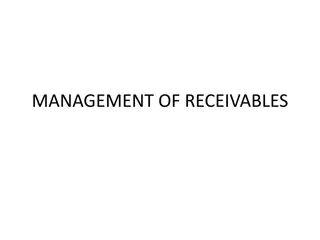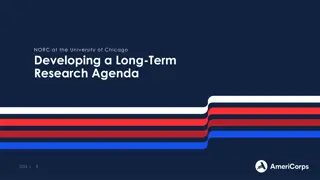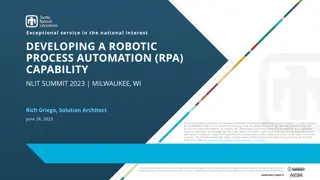Maximizing Credit Allocation through Cashless Policy in Developing Nations
The adoption of cashless policies can significantly impact credit allocation in developing nations by reducing risks, enhancing financial inclusion, combating crime, and speeding up transactions. This article explores the benefits and opportunities of leveraging cashless policies in the financial sector, with a focus on digital lending and the Nigerian cashless journey.
Download Presentation
Please find below an Image/Link to download the presentation.
The content on the website is provided AS IS for your information and personal use only. It may not be sold, licensed, or shared on other websites without obtaining consent from the author. Download presentation by click this link. If you encounter any issues during the download, it is possible that the publisher has removed the file from their server.
Presentation Transcript
Harnessing the Benefits of Cashless Policy on Credit Allocation in a Developing Nation Ikemefula Nwachukwu Head Personal Banking FirstBank of Nigeria Limited
Outline Outline 01 02 03 04 05 Introduction Overview f cashless Policy Benefits of Cashless Policy Leveraging the Benefits of a Cashless Policy Digital Lending 2
Introduction Introduction The The Financial Financial Sector plays plays a a critical critical part development development of of its Sector of of any part in in the the growth its economy economy any nation nation growth and One One of of the regulating regulating the the the Central Central bank the key key players players in in monitoring the activities activities of of this bank of of a a Country Country monitoring and this sector sector is is and and The The Cash initiatives initiatives aimed of of physical physical cash Cash- -less less policy policy is is one aimed at at reducing reducing the cash in in circulation circulation one of of such the amount amount such Central Central Banks formulating formulating regulate regulate the Banks are Monetary Monetary the supply supply of of money are responsible responsible for policies policies money for to to Financial Financial Institutions Institutions and leverage leverage on on the enhance enhance Credit Credit Allocation Countries Countries and businesses businesses can the gains gains of of this this policy Allocation in in Developing can A A cashless cashless economy transactions transactions, , Reduced risks, risks, Improve Improve financial check check crime crime & & corruption, money money supply, supply, etc economy leads Reduced cost, financial inclusion, corruption, control etc. . leads to to Faster cost, Reduced Reduced inclusion, Faster policy to to Developing control
Introduction - The Nigerian Cashless Journey - 2012 0% 1% 14% 85% POS Mobile/Web Cheque Cash With a highly informal economy, transactions in Nigeria were heavily cash-oriented with retail and commercial payments primarily in cash.
Enablers of Cashless Policy Enablers of Cashless Policy - - Nigeria Nigeria POS Terminals (900,000) Agents (1.4m) ATMs (14,000) QR Code & MoM Wallet Adoption GSM Lines (152) Source: CBN & Elfina 2021
Impact of Cashless Policy POS & Electronic Transfers Electronic Transfers Value POS TXNS VALUE 350,000,000,000,000.00 7,000,000,000,000.00 300,000,000,000,000.00 6,000,000,000,000.00 250,000,000,000,000.00 5,000,000,000,000.00 200,000,000,000,000.00 4,000,000,000,000.00 3,000,000,000,000.00 150,000,000,000,000.00 2,000,000,000,000.00 100,000,000,000,000.00 1,000,000,000,000.00 50,000,000,000,000.00 0.00 0.00 2012 2022 2012 2022
Benefits of A Cashless Policy Benefits of A Cashless Policy Reduced risks associated with physical cash Reduced Costs Greater Financial Inclusion Faster Transactions Access to Credit
How can Commercial Banks Leverage Cashless Policy for Digital Lending?
Expectations Digitalization Credit Big Data Expansion of financial access points (ATMs, POS, mCash) Proper KYC through digital footprints Financial Inclusion Monies saved can be used for lending Proliferation of e-payment platforms Financial Transaction history Increase in adoption of electronic channels. If banks reimagine and modernize their business- lending processes, they can take advantage of new opportunities to reach hitherto excluded segments
The Need for Transition to Digital Lending . Increased Access to Credit With an increased financial Inclusion landscape, more individuals and small business have access to credit. Lower Operating Costs Use of digital platforms increases efficiency and cost- effectiveness - allowing banks reduce their costs. Improved Risk Management A shift from traditional lending patterns to use of advanced algorithms and data analytics improves risk management and reduces likelihood of defaults. Quick Decision Making Reduces waiting time for Loan approvals and disbursements
Digital Lending Multiple digital business models to meet varying customer needs such as: Peer-to-peer(P2P) E-commerce and Social platforms Supply chain Lenders Online and Mobile lending platforms Origination, disbursal and collection of credit using non- traditional channels Technological advancements such as Internet APIs, cloud Computing, Smart phones Currencies. and Digital With segmentation, challenges related to geography transaction costs are eliminated Niche and specialized and higher DIGITAL LENDING IN NIGERIA (linkedin.com)
Benefits of Digital Lending Enhanced Customer Experience Improved Risk Management Reduced Costs New Business Models Faster Loan Processing
Challenges of Digital Lending in Commercial Banks Data Security Cost of Acquiring Digital Solutions Collection and Storage of Sensitive Customer data Cyber Security Threats Infrastructure for Digital Lending is capital Intensive Regulatory Compliance Compliance with specific regulations Data Protection Laws Product Marketing Integration with Legacy Systems Marketing Budgets for Digital Loan offerings are Huge Costs to Commercial Banks Incompatibility issues between core banking systems and digital lending solution Importance of Investing in technology
How can Commercial Banks Leverage Digital Lending? 1 2 3 4 5 Seamless Disbursement Customer Profiling Automated Underwriting Credit Monitoring Credit Advisory End-to-end process of disbursements ensures funds are automatically transferred to borrowers account Use of advanced algorithms to analyze borrower credit capacity and adjust loan limits based on repayments Platforms aggregate borrower data from various sources and make informed Lending Decisions. Track changes in borrower behavior and identify potential defaults. Improved collections Increased KYC leads to availability of data for: Segmentation Conversion Personalized offers
A comparison of Two Loan Offerings for Salary Earners with FirstBank in the Last 3 Years The FirstBank Journey Digital Loan Offering Traditional Loan The Digital Lending count grew by 127% 127% The traditional Loan count grew by 4.7% 4.7% in the same period Revenue for the Digital Loan 162% Disbursement product grew by 162% The Digital Lending solution grew by 96% from in Traditional Loan offering 96% Disbursements grew by 78% in the same 78% period Traditional Loan product grew by just 1.5% in the 1.5% same period
Conclusion To maximize this opportunity, Banks must: Invest in the Right technology Ensure Regulatory Compliance 50% 50% Traditional Banking DigitalLending Adoption of Digital lending can help Commercial Banks Streamline the loan application and approval process Reduce costs Improve customer Experience. Future of Commercial Banking lies in striking the balance between Digital Lending and Traditional banking services-providing customers best of both worlds
Thank Thank You You

















































